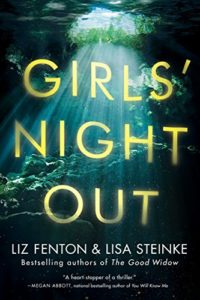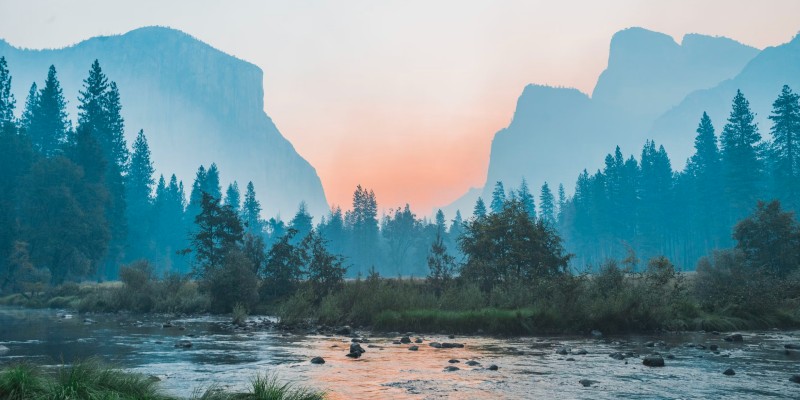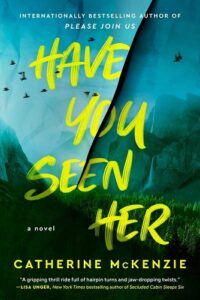Years ago I had a discussion with another author about someone’s work she admired. What stood out to her was that the setting came alive in this third author’s books. Trees weren’t just there—they lived and breathed and grabbed onto you. The ground wasn’t something you simply walked on—it sucked you in. And the air wasn’t only something that gave life, but it might also snuff it out. The idea excited me and the conversation stuck with me. Because—what if setting could be something more than the place where your novel takes place? What if it could shape the narrative? What if it was crucial to how the story panned out?
This is a common theme in gothics—those creepy old houses!—but what about outside that genre? Could setting be a character in a thriller or suspense novel too? And if so, how?
I sat with that idea for a long time. I played with it to a certain extent in my novel I’ll Never Tell, which is set at a summer camp whose location (but not events) is based on one that I attended for many years. I wanted to invoke sense memories in that book—the way a campfire smells, the sheltering pines, the brackish smell of the lake. But while the setting was important to the novel, it wasn’t crucial. I could’ve told that story in a different place without changing it drastically.
I still had work to do.
And then I started writing Have You Seen Her. It’s about Cassie Peters, a search and rescue worker who returns to Yosemite National Park after ten years away to resume that job and start over. Yosemite is essential to the plot, and I wanted to bring it alive as a character. The book is set in the Tuolumne Meadows section of the Park—less famous than the valley floor where Half Dome and El Capitan are.
As I wrote the novel, I wanted the reader to feel like they were there with Cassie even if they’d never even seen a picture of it at all, let alone visited. That they could feel the rough rockface beneath her hands as she went for a climb. Or that bone cold-chill of the waters of the crystal lakes. And the fear that the forest can instill, but also the stillness.
It’s a beautiful place, but also one where people get hurt. Where people go missing. Where people disappear.
Hopefully, I pulled it off. But, in case I didn’t, here’s a list of books that most definitely did, and ones I drew inspiration from as I was writing mine.

Girls Night Out by Liz Fenton and Lisa Steinke
Setting: Tulum, Mexico
Three friends go to Mexico for a girls’ trip to repair the wounds between them. But when one of them goes missing, secrets are revealed as the two remaining women desperately search for their friend. If you’ve ever been there, you know that the Mayan Riviera is a beautiful setting, but there’s a menace to it too, which Fenton & Steinke do a great job of evoking, especially in the scenes set in a cenote–a combination of a cave and sinkhole that has a shimmering beauty to it, but might just be the perfect place to hide a body. They brilliantly weave their setting—the Mayan ruins, the water, and some very strong margaritas—into the plot, including in the final twist that will leave you both surprised and satisfied.

The Overnight Guest by Heather Gudenkauf
Setting: An isolated farmhouse in a snowstorm
Sounds like a great place to write a book, right? That’s what author Wylie Lark thinks—that is until she discovers a small child outside in the raging storm. Oh, and did I mention that two people were murdered in the house twenty years ago? Is the house haunted or is that just Wylie’s imagination, fueled by the storm that’s battering the house and cutting them off from civilization?
For anyone who grew up where winter storms can rage, you know how isolating they can make you feel. When you can’t see the hand in front of your face or hear anything through the howling wind… It might seem cozy by that fire, but anything could be happening outside and you wouldn’t know it until it was too late.
Gudenkauf knits her story into the storm and the storm into the story perfectly so you can feel the bite of the cold and the slap of the storm.
One by One by Ruth Ware
Setting: an isolated ski lodge in the French Alps
Ruth Ware also uses snow to great effect in One by One, about a group of co-workers who rent an isolated ski lodge on the top of a mountain in the French Alps for a corporate retreat. After one of them goes missing, and a storm closes in, secrets are revealed, and fear mounts. The cold plays a role here too, as the temperature drops by the hour and it’s impossible to bring in supplies or anyone to rescue them until the storm abates. The fantastic slopes that they’d enjoyed in the sunshine the day before turn into a menacing presence and constant danger.
The Guest List by Lucy Foley and Her Dark Lies by JT Ellison
Setting: An island off the coast of somewhere
Did Agatha Christie do this first in And Then There Were None? I’m not a book historian, but certainly, ever since that book, the idea of a group gathered on an island with a potential killer among them has had a constant appeal. Two recent, and great, entries into this field are The Guest List and Her Dark Lies. Both novels use their setting to great effect—the boat ride to the island, the dark nooks and crannies that islands have, the isolation.
Because how long does it take for you to get cut off from the mainland? And how easy is it for the thin veneer of civilization to be stripped away?
Both books also use a wedding as a device. In Her Dark Lies, it’s the protagonist’s impending wedding that’s threatened, by the island itself, it seems. Or is it by her almost-to-be-husband’s family?
And in The Guest List, it’s the guests that are under threat, as a body is found during the reception, and the guests discover just how alone they are.
I read these two novels back-to-back and they’re great companion pieces to one another.
So next time you read a book—one of mine or someone else’s—ask yourself whether the setting is a character and whether it should be. It will take you great places.
***




















